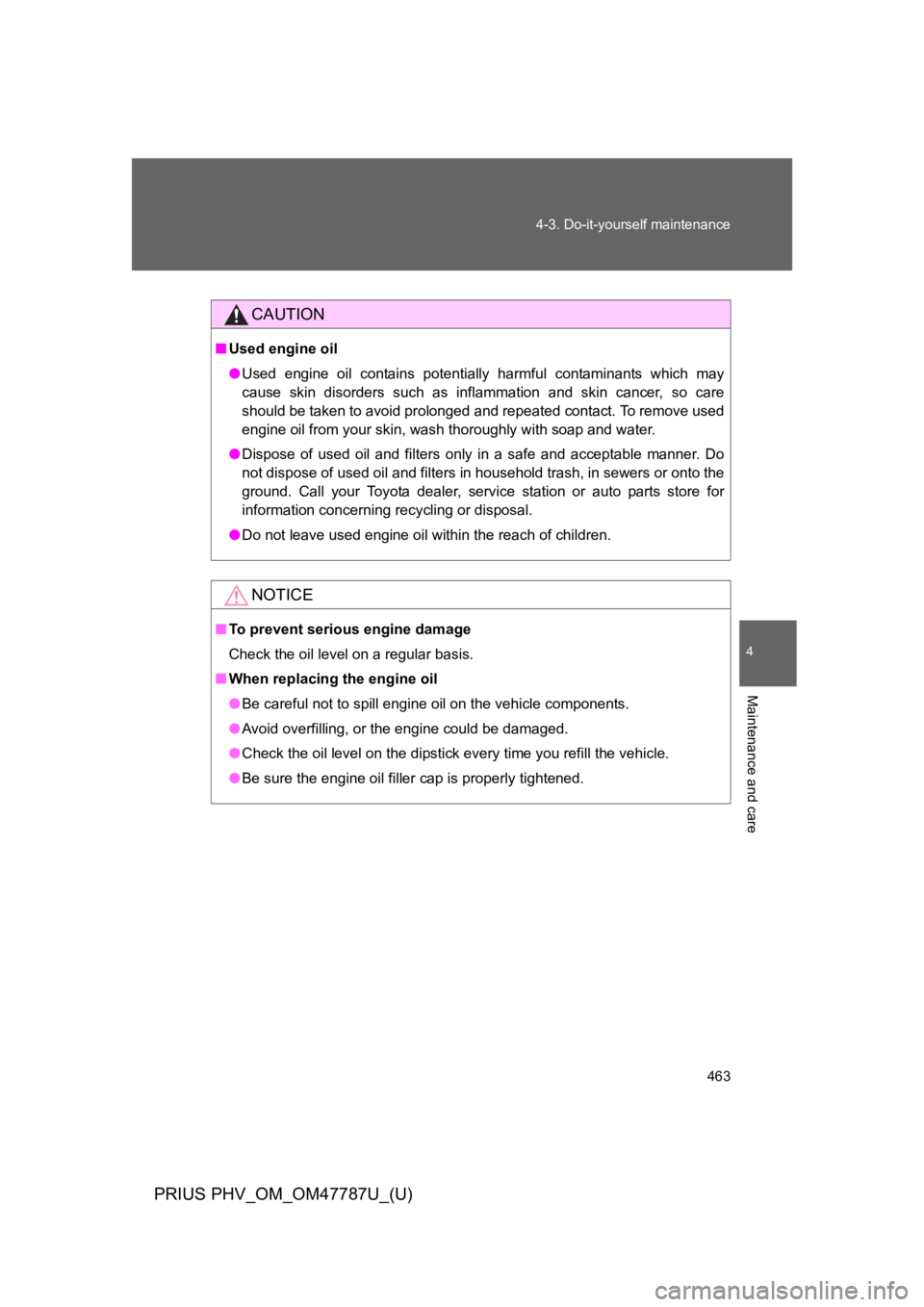Page 456 of 704

432
4-2. Maintenance
PRIUS PHV_OM_OM47787U_(U)
■Reset the maintenance data (U.S.A. only)
After the required maintenance is performed according to the maintenance
schedule, please reset the maintenance data.
To r e s e t t h e d a t a , f o l l o w t h e p r o c e d u r e s d e s c r i b e d b e l o w :
Turn the “POWER” switch off with the trip meter A shown.
Turn the “POWER” switch to ON mode with the MPH or km/h button
(→P. 2 5 9 ) h e l d d o w n .
Keep pressing the button until the trip meter indicates “000000” and
the multi-information display indicates that the reset is complete.
■Allow inspection and repairs to be performed by a Toyota dealer
●Toyota technicians are well-trained specialists and are kept up to date
with the latest service information. They are well informed about the
operation of all systems on your vehicle.
●Keep a copy of the repair order. It proves that the maintenance that has
been performed is under warranty coverage. If any problem should arise
while your vehicle is under warranty, your Toyota dealer will promptly
take care of it.
STEP 1
STEP 2
STEP 3
Page 458 of 704
434
4-2. Maintenance
PRIUS PHV_OM_OM47787U_(U)
General maintenance
Engine compartment
ItemsCheck points
Brake fluidIs the brake fluid at the correct
level? (→P. 4 6 7 )
Engine/power control unit coolant
Is the engine/power control unit
coolant at the correct level?
(→P. 4 6 4 )
Engine oilIs the engine oil at the correct
level? (→P. 4 6 0 )
Exhaust systemThere should not be any fumes or
strange sounds.
Radiator/condenser
The radiator and condenser
should be free from foreign
objects. (→P. 4 6 6 )
Washer fluidIs there sufficient washer fluid?
(→P. 4 6 9 )
Listed below are the general maintenance items that should be per-
formed at the intervals specified in the “Owner’s Warranty Informa-
tion Booklet” or “Owner’s Manual Supplement/Scheduled
Maintenance Guide”. It is recommended that any problem you notice
should be brought to the attention of your Toyota dealer or qualified
service shop for advice.
Page 462 of 704

438
4-2. Maintenance
PRIUS PHV_OM_OM47787U_(U)
Emission inspection and maintenance (I/M) programs
Some states have vehicle emission inspection programs which
include OBD (On Board Diagnostics) checks. The OBD system moni-
tors the operation of the emission control system.
■If the malfunction indicator lamp comes on
The OBD system determines that a problem exists somewhere
in the emission control system. Yo u r v e h i c l e m a y n o t p a s s t h e I /
M test and may need to be repaired. Contact your Toyota dealer
to service the vehicle.
■Yo u r v e h i c l e m a y n o t pa s s t h e I / M t e s t i n t h e f o l l o w i n g s i t u a -
tions:
●When the 12-volt battery is disconnected or discharged
Readiness codes that are set during ordinary driving are
erased.
Also, depending on your driving habits, the readiness codes
may not be completely set.
●When the fuel tank cap is loose
The malfunction indicator lamp comes on indicating a tempo-
rary malfunction and your vehicle may not pass the I/M test.
■When the malfunction indicator lamp still remains on after
several driving trips
The error code in the OBD system will not be cleared unless the
vehicle is driven 40 or more times.
■If your vehicle does not pass the I/M test
Contact your Toyota dealer to prepare the vehicle for re-testing.
Page 482 of 704
458
4-3. Do-it-yourself maintenance
PRIUS PHV_OM_OM47787U_(U)
NOTICE
■When replacing the tires
When removing or fitting the wheels, tires or the tire pressure warning
valve and transmitter, contact your To y o t a d e a l e r a s t h e t i r e p r e s s u r e
warning valve and transmitter may be damaged if not handled correctly.
■To a v o i d d a m a g e t o t h e t i r e p r e s s u r e w a r n i n g v a l v e s a n d t r a n s m i t -
ters
When a tire is repaired with liquid sealants, the tire pressure warning
valve and transmitter may not operate properly. If a liquid sealant is
used, contact your Toyota dealer or other qualified service shop as soon
as possible. Make sure to replace the tire pressure warning valve and
transmitter when replacing the tire. (→P. 4 7 7 )
Page 487 of 704

463
4-3. Do-it-yourself maintenance
PRIUS PHV_OM_OM47787U_(U)
4
Maintenance and care
CAUTION
■Used engine oil
●Used engine oil contains potentially harmful contaminants which may
cause skin disorders such as inflammation and skin cancer, so care
should be taken to avoid prolonged and repeated contact. To remove used
engine oil from your skin, wash thoroughly with soap and water.
●Dispose of used oil and filters only in a safe and acceptable manner. Do
not dispose of used oil and filters in household trash, in sewers or onto the
ground. Call your Toyota dealer, service station or auto parts store for
information concerning recycling or disposal.
●Do not leave used engine oil within the reach of children.
NOTICE
■To p r e v e n t s e r i o u s e n g i n e d a m a g e
Check the oil level on a regular basis.
■When replacing the engine oil
●Be careful not to spill engine oil on the vehicle components.
●Avoid overfilling, or the engine could be damaged.
●Check the oil level on the dipstick every time you refill the vehicle.
●Be sure the engine oil filler cap is properly tightened.
Page 509 of 704

485
4-3. Do-it-yourself maintenance
PRIUS PHV_OM_OM47787U_(U)
4
Maintenance and care
NOTICE
■Repairing or replacing tires, wheels, tire pressure warning valves,
transmitters and tire valve caps
●When removing or fitting the wheels, tires or the tire pressure warning
valves and transmitters, contact your Toyota dealer as the tire pres-
sure warning valves and transmitters may be damaged if not handled
correctly.
●When replacing tire valve caps, do not use tire valve caps other than
those specified. The cap may become stuck.
■To a v o i d d a m a g e t o t h e t i r e p r e s s u r e w a r n i n g v a l v e s a n d t r a n s m i t -
ters
When a tire is repaired with liquid sealants, the tire pressure warning
valve and transmitter may not operate properly. If a liquid sealant is
used, contact your Toyota dealer or other qualified service shop as soon
as possible. Make sure to replace the tire pressure warning valve and
transmitter when replacing the tire. (→P. 4 7 7 )
■Driving on rough roads
Ta k e p a r t i c u l a r c a r e w h e n d r i v i n g on roads with loose surfaces or pot-
holes.
These conditions may cause losses in tire inflation pressure, reducing
the cushioning ability of the tires. In addition, driving on rough roads may
cause damage to the tires themselves, as well as the vehicle’s wheels
and body.
■If tire inflation pressure of each tire becomes low while driving
Do not continue driving, or your tires and/or wheels may be ruined.
Page 516 of 704
492
4-3. Do-it-yourself maintenance
PRIUS PHV_OM_OM47787U_(U)
CAUTION
■Use of defective wheels prohibited
Do not use cracked or deformed wheels.
Doing so could cause the tire to leak air during driving, possibly causing
an accident.
NOTICE
■Replacing tire pressure warning valves and transmitters
●Because tire repair or replacement may affect the tire pressure warn-
ing valves and transmitters, make sure to have tires serviced by your
To y o t a d e a l e r o r o t h e r q u a l i f i e d s e r v i c e s h o p . I n a d d i t i o n , m a k e s u r e t o
purchase your tire pressure warning valves and transmitters at your
To y o t a d e a l e r .
●Ensure that only genuine Toyota wheels are used on your vehicle.
Tire pressure warning valves and transmitters may not work properly
with non-genuine wheels.
Page 548 of 704
5
When trouble arises
525
5-1. Essential information
PRIUS PHV_OM_OM47787U_(U)
If your vehicle needs to be towed
Before towing
The following may indicate a problem with your hybrid transmission.
Contact your Toyota dealer before towing.
●The hybrid system is operating but the vehicle will not move.
●The vehicle makes an abnormal sound.
If there is a malfunction in the P position control system, the smart
key system or the immobilizer system, or if the 12-volt battery is dis-
charged, the vehicle cannot be towed with the front wheels on the
ground, as the front wheels may be locked. In this case, transport the
vehicle with both front wheels or all four wheels lifted.
If towing is necessary, we recommend having your vehicle towed by
your Toyota dealer or a commercial towing service, using a lift-type
truck or flat bed truck.
Use a safety chain system for all towing, and abide by all state/pro-
vincial and local laws.